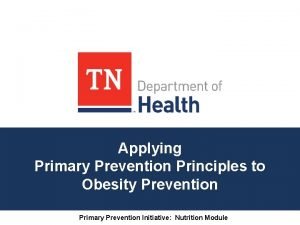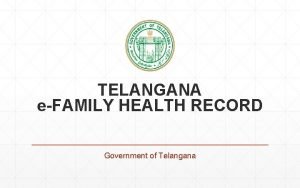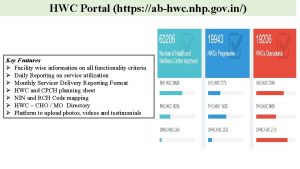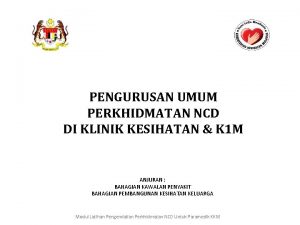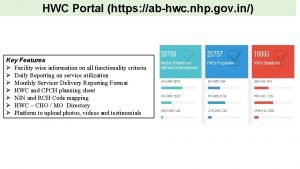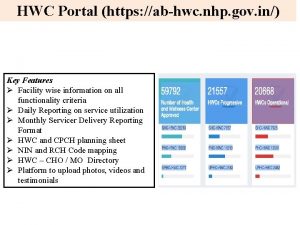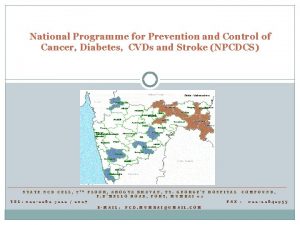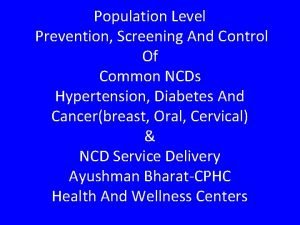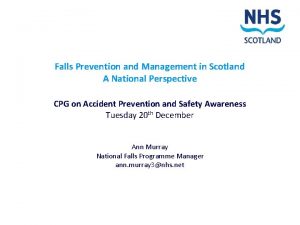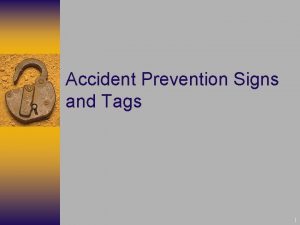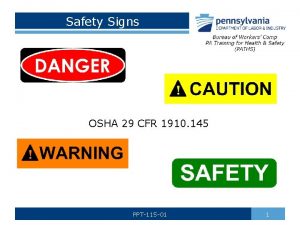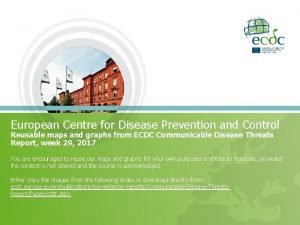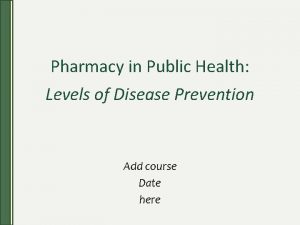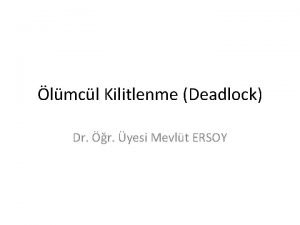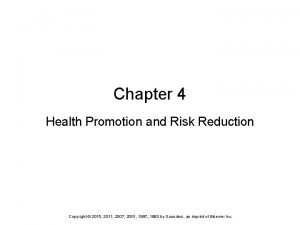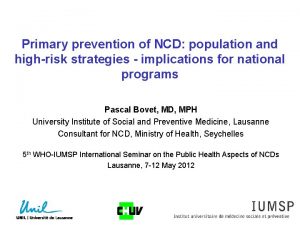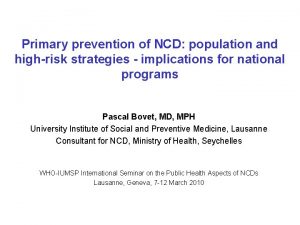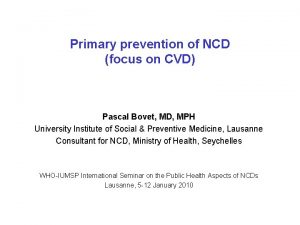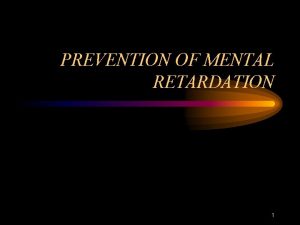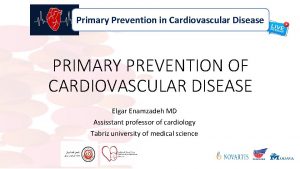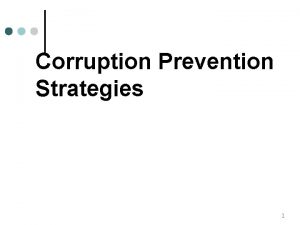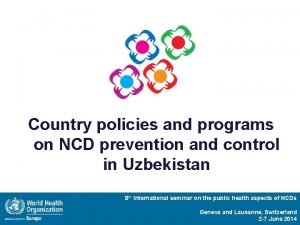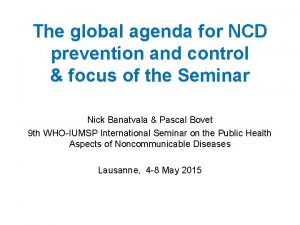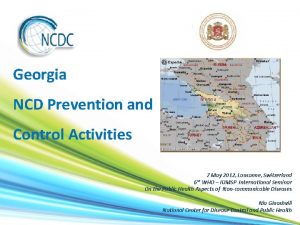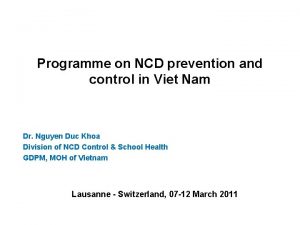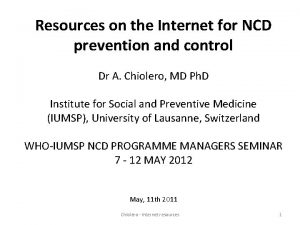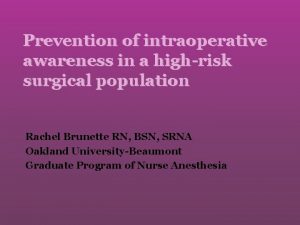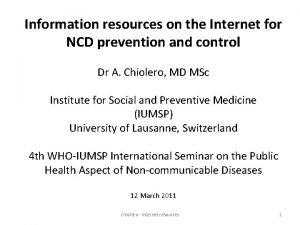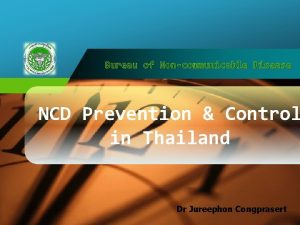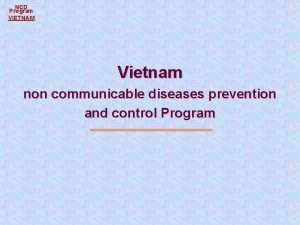Primary prevention of NCD population and highrisk strategies










































- Slides: 42

Primary prevention of NCD: population and high-risk strategies - implications for national programs Pascal Bovet, MD, MPH University Institute of Social and Preventive Medicine, Lausanne Consultant for NCD, Ministry of Health, Seychelles 6 th WHO-IUMSP International Seminar on the Public Health Aspects of NCDs Lausanne, 7 -12 May 2012

• • • Are NCD/CVD preventable, to which extent? Risk factors of NCD/CVD and their characteristics ‘Population’ strategies and ‘high risk’ strategies Limitations and opportunities for NCD/CVD prevention Conceptual framework for planning NCD/CVD prevention & control

Different CVD rates underlie large potential for prevention Trends in IHD, 1950 -1987, age 45 -64 Thom et al. NIH Publication 92 -3988

Main risk factors for NCD/CVD Underlies rationale for prevention strategies) Non-modifiable RF: • age, sex, history Socio-economic & cultural determinants Early life characteristics Behavioral RF: • Smoking • Unhealthy diet (salt, sat fat, lack fruit & veg) • Sedentary lifestyle Physiological RF: • Hypertension • High cholesterol • Diabetes • Obesity CVD endpoints: • Isch. heart disease • Stroke • Vascular disease • Heart failure NCD endpoints: • Some cancers • Respirat. diseases • Renal disease But not RHD, endocarditis, cardiomyopathies

Risk for CVD, diabetes and cancer largely reduced by healthy living Four healthy behaviors: tobacco, physical activity, diet, overweight (EPIIC–Potsdam, age 35 -65 yr, adjusted for SES Ford ES et al. Healthy living is the best revenge. Findings from the European Prospective Investigation Into Cancer and Nutrition–Potsdam Study. Arch Intern Med 2009; 169: 1355 -1362.

31 -yr CHD, CVD, and all cause mortality by number of RF: up to 80% CVD cases could be prevented if all persons had 0 RF Daviglus ML, Stamler, et al. Favorable cardiovascular risk profile in young women and long-term risk of CVD and allcause mortality JAMA. 2004; 292: 1588 -1592

Decline in CVD in Western countries (1980 -2000) was due more to reduction in RF in populations than treatment Risk Factors worse +17% Risk Factors better -65% Treatments AMI treatments -10% Secondary prevention -11% Heart failure -9% Angina: CABG & PTCA -5% HBP therapies -7% Statins (prim. prev. ) -5% -47% Obesity (increase) Diabetes (increase) Population BP fall Smoking Cholesterol (diet) Physical activity Unexplained Ford et al. NEJM 2007; 356: 2388. Capewell S, O'Flaherty M. What explains declining coronary mortality? Lessons and warnings. Heart 2008; 94 1105 -8. +7% +10% -20% -12% -24% -5% -9%

CHD mortality falls attributed to treatment vs. reduction of risk factors in the population in various countries NEJM 2007; 356: 2388.

• • • Are NCD/CVD preventable, to which extent? Risk factors of NCD/CVD and their characteristics ‘Population’ strategies and ‘high risk’ strategies Limitations and opportunities for NCD/CVD prevention Conceptual framework for planning NCD/CVD prevention and control

Approaches to NCD/CVD primary prevention Distribution density Avoid development of new cases Risk factor « Population strategy » • Public health approach • Targets entire population • Interventions outside MOH « High-risk strategy » • Screening & treatment of RF • Targets selected individuals • Individual based “clinical” • Small reduction in entire population (small effect in many) • Radical attempt to deal with underlying causes • Identify people with high risk and treat them (large effect in a few) • Rescue operation (delays consequences)

Distribution density Linear relation between RF and NCDs implies that benefits of population strategies can extend to entire population (“good for all” vs “good for some”) Risk factor Rose G. Sick individuals and sick populations. Int J Epidemiol 1985; 14: 32– 8).

Distribution of RF in the population and impact on disease Large proportion of cases arise from majority with low RF level Prevalence of RF in population (%) Risk of an event due to RF (%) Distribution of patients with event due to RF 30 25 70% 20 % 15 50% 10 5 0 0 1 2 3 4 5 6 7 Decile of risk factor Wilhelmsen et al. Clin Sci 1979; 57: 455 S 8 9 10

RR, RF prevalence and attributable fraction for stroke Low impact of strategies targeting high-risk patients SBP No men Deaths <110 110 -119 120 -129 130 -139 21, 379 66, 080 98, 834 79, 308 202 658 1, 324 1, 576 140 -149 150 -159 44, 388 21, 477 1, 310 946 27. 3 38. 1 160 -169 170 -179 180+ 9, 308 4, 013 3, 191 488 302 335 44. 8 65. 5 85. 5 Excess risk % CHD attributable to high BP 0 33 376 738 0 11. 5 22. 60 3. 63 748 593 22. 8 18. 2 41. 0 4. 27 6. 24 8. 14 319 221 239 9. 8 6. 8 7. 3 23. 9 Rate Relative Per 1000 risk of CVD 1. 00 10. 5 11. 05 14. 3 1. 36 19. 8 1. 89 35. 1 Men free of CVD at baseline; excess deaths: difference between observed and expected at lower rate (<110) Stamler R. The BP problem: risks and their reduction (MRFIT). Cardiovasc Risk Fact, 1: 71 -9

Risk factors: characteristics underlying prevention strategies • Continuum relation between RF and NCD/CVD over a wide range (rather than across arbitrary thresholds) • Multiplicative risk arising from combination of RF • Clustering of CVD RF is common due to similar lifestyle associations • In any community, largest number of NCD/CVD events arises from persons with modest RF elevations (not eligible to treatment): Ø >80% of CVD could be averted if distribution of RF was low in pop. Ø All people have some level of RF: emphasis on population strategies Ø Clustering: integrated strategies aimed at multifactorial risk reduction

• • • Are NCD/CVD preventable, to which extent? Risk factors of NCD/NCD and their characteristics ‘Population’ strategies and ‘high risk’ strategies Limitations and opportunities for NCD/CVD prevention Conceptual framework for planning NCD/CVD prevention and control

Need to tackle «sick» populations, not merely deviant individuals • Root of cholesterol problem lies in a characteristic of the population as a whole • Need to target 'sick populations’, not merely ‘deviant individuals’ (i. e. shift distribution of RF in entire populations) • Response: e. g. North Karelia prevention program Rose G. CHD epidemiology. Oxf. Med Pub 1995

NCD risk behaviors: merely a matter of personal choice? • An element of personal responsibility • But, also, if we want people to make health choices we have to make healthy choices available

Examples of interventions targeting the entire population 1) Educational interventions • Media, school, workplace 2) Transportation policies (change environment) • Limit role of automobile (and increase use of buses): promote walking/cycling, pedestrian zones, safe well lit green areas, sidewalks • Health promoting cities and environments 3) Improve food supply (change environment) • Improve process and manufacturing (salt, trans fat, saturated fats, etc) • Increasing availability and reducing cost of healthy foods • Promoting healthy food choices and limiting marketing to children 4) Economic policies: incentives and disincentives • Tax on tobacco • Differential taxes for energy dense foods/fruits-vegetables 5) Initiatives at the community level • Most effective when multifaceted, involving community • Dose of intervention and duration must be large enough Prevention of chronic diseases by means of diet and lifestyles changes. Disease Control Priorities in Developing Countries (DCPC 2), World Bank & WHO, 2006


Shaping the environment: improvement in street design

Higher price of cigarettes (i. e. tax) is a powerful measure to curb tobacco use, UK, 1971 -96 Central Statistical Office (UK) (1965 -97)

Restriction of artificial trans fat in New York City Angell SY et al. Cholesterol Control Beyond the Clinic: NY City’s Trans Fat Restriction. Ann Intern Med. 2009; 151: 129134

A natural experiment: trends in diet and CVD in Poland before/after market liberalization Zatonsky et al. BMJ 1998; 316: 1047– 51

Cost-effectiveness of interventions to reduce dietary salt intake Cobiac et al. Cost-effectiveness of interventions to reduce dietary salt intake. Heart 2010; 96: 1920 e 1925

Five key global commitments to action that will guide 8 major food companies over the next five years and beyond (…).

• • • Are NCD/CVD preventable, to which extent? Risk factors of NCD/CVD and their characteristics ‘Population’ strategies and ‘high risk’ strategies Limitations and opportunities for NCD/CVD prevention Conceptual framework for planning NCD/CVD prevention and control

High-risk strategies (who to screen and treat? ): Multiplicative effect of concomitant RF on IHD incidence Stamler J. Established major coronary risk factors. In Marmot et al. CHD epidemiology from etiology to public health. OUP, 1992

Assessing total CVD risk: the New Zealand guidelines

Prescribing treatment is no guarantee of result…

Low treatment uptake 12 months after HBP screening in a random sample of population of Dar es Salaam, Tanzania ~10’ 000 adults of general population screened for BP 161 with BP >160/95 on 4 visits in 6 weeks Advised to seek HC Follow-up 1 year later Bovet et al. Low utilization of health care services following screening for hypertension in Dar es Salaam (Tanzania): a prospective longitudinal study. BMC Public Health 2008; 8: 407.

Population vs. high-risk approaches: need for both • High-risk and population interventions are mutually supportive • Counseling to high-risk persons extends to relatives, friends, colleagues • Population strategy is essential if attempts of individuals to change their lifestyles are not to turn them into social outcasts (normative role, molding opinions) • High-risk individuals are quantitatively but not qualitatively different people: tail of a continuous distribution of RF Rose G. CHD epidemiology. Oxford Med Pub 1995

Relation between population strategies and high-risk strategies for NCD/CVD prevention and control Individual-based highrisk strategy: Screening & treatment in high-risk individuals RF & NCD Population strategy (enabling adoption of healthy behaviors): Health education Healthy policy Healthy environment + surveillance of RF for guiding & monitoring interventions

High-risk and population approaches High risk (individual) Population + (screening) label case as “sick” - Large (if cooperative) Small Benefit for population Small Large Cooperation required (understanding, motivation) Large Little Cost High Potentially low Palliative (delays disease) Radical ( incidence) Often good for individuals May oppose economic interests Need to identify individuals Benefit for individual Level of intervention Acceptability

Putting NCDs on the global agenda: UN High-Level Meeting on NCDs (New York, 19 -20 Sep 2011)

Best buys for NCD prevention and control *Prevention* Reducing the level of exposure to risk factors *Management* Strengthen health care for people with NCDs Risk factor / disease "Best buy" Interventions Tobacco use - Harmful use of alcohol - Raise taxes on alcohol - Restrict access to retailed alcohol - Enforce bans on alcohol advertising Unhealthy diet and physical inactivity - Reduce salt intake in food - Replace trans fat with polyunsaturated fat - Promote public awareness about diet and physical activity Cardiovascular disease and diabetes - Provide counselling and multi-drug therapy for people with medium-high risk of developing heart attacks and strokes - Treat heart attacks with aspirin Cancer - Hepatitis B immunization beginning at birth to prevent liver cancer - Screening and treatment of pre-cancerous lesions to prevent cervical cancer Raise taxes on tobacco Protect people from tobacco smoke Warn about the dangers of tobacco Enforce bans on tobacco advertising

Lessons learnt from NCD prevention programs worldwide • Cumulative lifelong exposure to RF: start interventions early • Most causes of CVD (“causes of the causes”) lie beyond the health sector: need for multisectoral interventions (partnerships) • Interventions: need for large enough doses and for enough time • Importance of using different settings for interventions • Issue of individual behaviour change vs. structural changes

Challenges for NCD/CVD prevention • Limited data/recognition of magnitude of NCD epidemic - advocacy • Myths: CVD affect the old, the rich, and are personal choices • Double burden of disease: “finish infectious diseases agenda first” • Prevention not given priority vs. treatment acute conditions • Powerful vested interests (tobacco, food industry, cars, agriculture) • (pop strategy): need to influence policy makers of non-health departments (“politics of prevention”) • (HR strategy): stroke/CHD/HBP/DM considered diseases for specialist • PHC in LMIC not adapted for health care for chronic conditions • High costs of NCD/CVD management & dwindling resources: necessity to focus on population-wide interventions (tobacco, salt)

Mutually reinforcing co-benefits of priority actions for NCD Heath benefits (reductions in): • Blindness, amputations, and other complications of diabetes • Dental caries • Domestic violence • Infectious diseases—eg, tuberculosis • Injuries, including road traffic injuries, and falls • Maternal and infant mortality and morbidity • Renal diseases Other benefits • Reduction in carbon footprint and greenhouse gases • Reduction in environmental pollution • Reduction in poverty • Improvements in built environments • Improvement in economic growth and productivity • Improvement in local food production • Improvement in social interaction Beaglehole R et al. Priority actions for the non-communicable disease crisis. Lancet 6 apr 2011

• • • Are NCD/CVD preventable, to which extent? Risk factors of NCD/CVD and their characteristics ‘Population’ strategies and ‘high risk’ strategies Limitations and opportunities for NCD/CVD prevention Conceptual framework for planning NCD/CVD prevention

Prevention & control of NCD: a simple framework Modifiable behaviors: • Tobacco • Physical inactivity • Unhealthy diet ( salt, fats& sugar, fruits/veg) Pathophysiological RF • Hypertension • High cholesterol • Diabetes • Obesity • IHD • Stroke • Peripheral artery dis. • Heart failure • Other NCD: cancers, etc Cost effective Rx • Screening and treatment for acute NCD of high-risk individuals for cases selected conditions + Surveillance • Guide & evaluate Primary prevention (decrease incidence of new cases) intervention Population strategy: • Environment • Policy • Education High-risk strategy:

Policy framework for NCD prevention and control (to speed transition to optimal health stage in populations) Reducing energy intake, incr. PA, red. smoking, etc Adapted from: Sacks et al. Obes Rev 2008 (from WHO Global Strategy on Diet, PA and Health: a Framework to monitor and evaluate implementation)

Conclusions Ø Modifiable RF of NCD are known as well as effective interventions Ø Apply the knowledge Ø Need for population approaches (high impact, potentially low cost) Ø Majority of NCD cases arise from persons with fairly low risk Ø Focus on population-wide interventions (radical, affordable) Ø Most effective PH interventions are outside of health sector Ø Need for selected high-risk approaches (screen & treat) Ø High cost, limited efficacy, commercial interests: need for careful selection Ø Can be good entry points for other programs/policy Ø Multifactorial nature of NCD underlie need for multi-sectoral action, coordination & partnerships
 Primary prevention secondary prevention tertiary prevention
Primary prevention secondary prevention tertiary prevention Chapter 4 section 1 population dynamics study guide
Chapter 4 section 1 population dynamics study guide Section 1 population dynamics answer key
Section 1 population dynamics answer key Population ecology section 1 population dynamics
Population ecology section 1 population dynamics Chapter 4 population dynamics study guide answers
Chapter 4 population dynamics study guide answers Primary prevention examples
Primary prevention examples Primary prevention obesity
Primary prevention obesity Site:slidetodoc.com
Site:slidetodoc.com Jhs.telangana.gov.in
Jhs.telangana.gov.in Ncd schoology
Ncd schoology Ncd. nhp. gov. in
Ncd. nhp. gov. in Contoh penyakit tidak berjangkit
Contoh penyakit tidak berjangkit Ncd
Ncd Https//ab-hwc.nhp.gov.in/daily report
Https//ab-hwc.nhp.gov.in/daily report Abhwc nhp.gov.in
Abhwc nhp.gov.in Ncd center dh amravati address
Ncd center dh amravati address Ncd anm login
Ncd anm login The primary pigments are _____ the primary colors.
The primary pigments are _____ the primary colors. Spill response steps
Spill response steps Prevention and combating of corrupt activities act summary
Prevention and combating of corrupt activities act summary Dfpc jprs
Dfpc jprs Injury prevention, safety and first aid
Injury prevention, safety and first aid Falls prevention scotland
Falls prevention scotland Puncture resistant container
Puncture resistant container Chapter 26 infectious disease prevention and control
Chapter 26 infectious disease prevention and control Chapter 19 disease transmission and infection prevention
Chapter 19 disease transmission and infection prevention Accident prevention signs and tags
Accident prevention signs and tags Accident prevention signs and symbols
Accident prevention signs and symbols Industrial safety signs and symbols ppt
Industrial safety signs and symbols ppt Osha needlestick protocol
Osha needlestick protocol Leavel
Leavel European centre for disease prevention and control
European centre for disease prevention and control Deadlock prevention avoidance and detection
Deadlock prevention avoidance and detection Health promotion and levels of disease prevention
Health promotion and levels of disease prevention Policy on harassment prevention and resolution
Policy on harassment prevention and resolution Starvation deadlock
Starvation deadlock Ppt116
Ppt116 Chapter 19 disease transmission and infection prevention
Chapter 19 disease transmission and infection prevention Health promotion and levels of disease prevention
Health promotion and levels of disease prevention 5 levels of prevention leavell and clark
5 levels of prevention leavell and clark School crisis prevention and intervention
School crisis prevention and intervention Osha subpart for fire protection and prevention
Osha subpart for fire protection and prevention Serious injury and fatality prevention
Serious injury and fatality prevention






